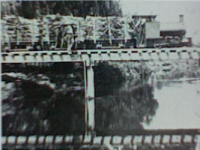Home-Shannon heritage
- History Of Shannon School
- Do You Remember the Time?
- Home Away from Home - Poutu Pa
- George Vance Shannon
- Edward Law 1864-1939
- Vogel Street
- Gunnings Go For It!
- Shannon Post Office
- Shannon Fire Station
- Shannon Railway Train Station
- Shannon Police Station
- A Mooing Hit and Miss
- The Shannon Bowling Club
- The Shannon Memorial Hall
- The Golden Days of Shannon Rugby
- Albion Tavern Shannon
- Club Hotel
- Renown Movie Cinema
- Mangahao Power to the People!
- Boxing - The Box Factory
- Flax Mills
- Our team
- Research process
- Learning outcomes
- References and acknowledgements
Flax Mills
In the Horowhenua there were two flax mills known to the locals as Miranui and Makerua.
Before Europeans came to New Zealand the Maori people discovered that flax had many uses. The Maori called fibre-muka. The Maori scraped the flax-harakeke to get the muka-fibre to make things such as piupiu, korowai, poi, whaariki, tukutuku, kete, taaniko, animal traps and weapons. The Pakeha discovered flax fibre was good for farming and rope.
In 1867 a machine was made, it was a machine that would scrape the flax-harakeke faster instead of the Maori doing it by hand using mussel shells. One at a time small mills started opening all over the country producing fibre for North America and Europe.
The first Manawatu flax mill was built in 1869.
In 1902 a man named William Allan Chappel was determined to help the growth of flax - pa harakeke. Later on that year he was successful with flax bushes weighing up to ninety pounds. the flax milling paddocks didn’t have much room to carry anymore harakeke.
A Barclay engine would carry wagons full of green harakeke over the Tokomaru River. The Makerua swamp block was owned by A.L. Seifert Flax Milling Company Ltd who established the Miranui flax mill 1907. Their main line ran from the mill to the swamp, to cart the harakeke for processing.
Flax milling was one of the most important things in Shannon. Now, in our day the only trace of Miranui flax mill is the red brick fence with a sign ‘Miranui’ - there is no trace of the Makerua flax industry.
The location of where most of the harakeke was growing and still is would be the Moutou and Makerua. The swamp nearly covered five thousand acres. Forty tons of flax was cut to the acre.
The Makerua swamp was the largest commercial harakeke operation in the country and extended from Shannon to Linton and followed the East bank of the Manawatu river. The area covered about twenty two thousand acres.
A large number of men were employed to work in the mills. The Miranui flax mill was the largest harakeke mill ever to be built producing New Zealand fibre out of harakeke. The Miranui flax mill was located three miles north of Shannon.
There were seven stripping machines in the main building called the Welxa mill. The quantity of leaf cut per annum, was the average of twenty two thousand tons. Three acres of flax was cut everyday. Eleven tramline-(horse cart) would be pulled up and relaid all day. The output of the mill was two thousand five hundred of hemp, and four hundred tons of tow. It was owned by A.L. Seiferts flax dressing company who employed over three hundred men and women.
Another mill further north called Mukapai flax mill with two stripping machines was situated over the Manawatu River. There was also another flax mill called Whitanui mill. This mill had four strippers. Both these mills got their supplies of flax from the Makerua swamp.
For many years flax milling was an amazing industry, providing two hundred and fifty thousand exports every year. But in 1914 a disease spread through the flax. The disease was called the yellow leaf disease. It was called that because the flax would turn yellow and die.
The locals would try to stamp it out, but the disease resisted everything.
The disease made flax milling unprofitable so drainage work was carried out into the swamp, changing it to a fertile plain. Flax owners converted their flax land into farming. Now the flax land is one of the finest root crop growing areas in the North Island.
Acknowledgements
Key note speakers - Maki Rauhihi, Mona Anderson
From Bush and Swamp by Marjorie Law
Shannon History by Elizabeth Liddell
Interview - Tracey Tanoa
Kete Horowhenua Miranui Flax Mill
Team effort by Osheanah (Year 7) and Rangi (Year 8).



